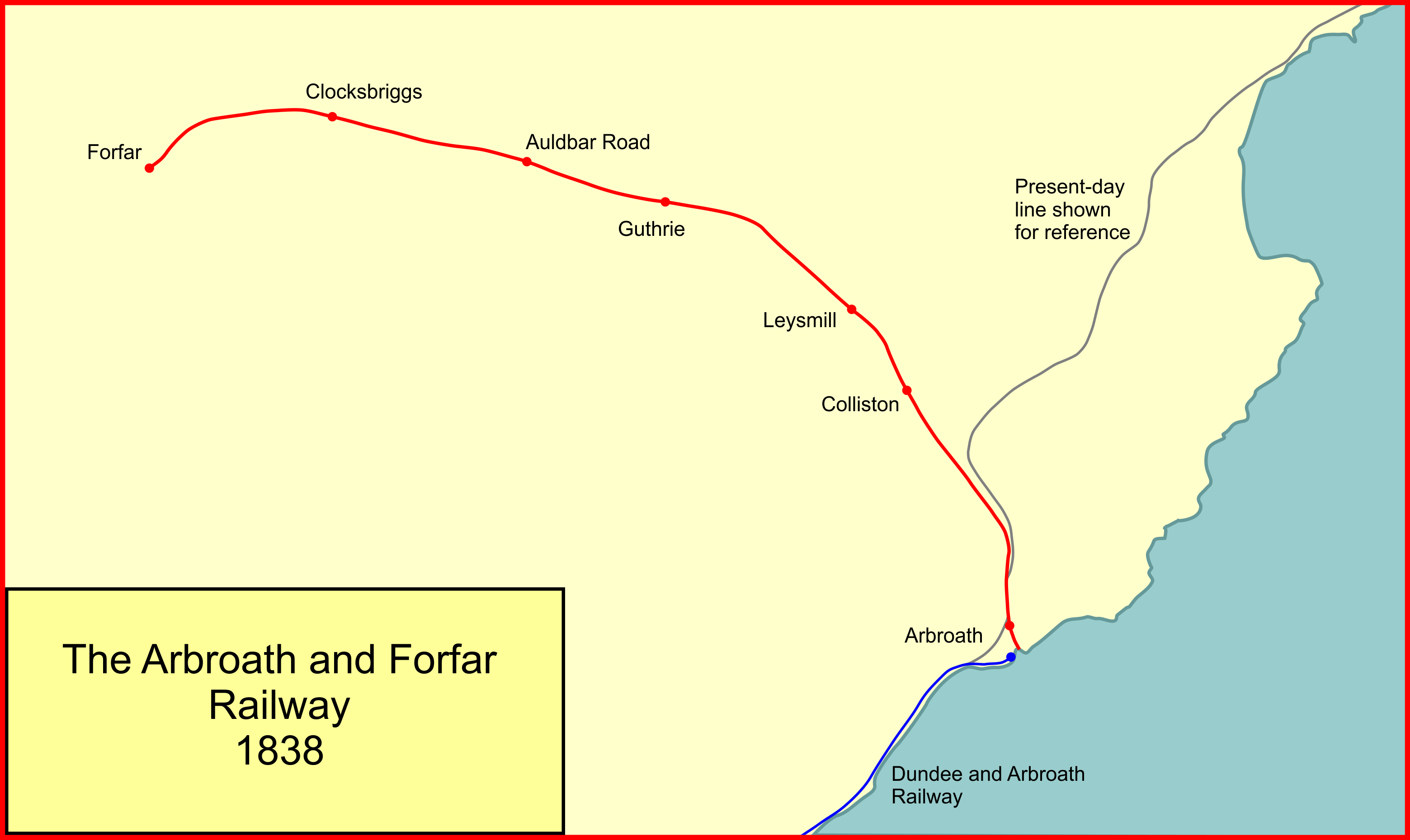|
Forfar Playfield Railway Station
Forfar Playfield railway station served the town of Forfar, Angus, Scotland from 1838 to 1848 on the Arbroath and Forfar Railway. This was the first station to serve Forfar. A through-station, Forfar railway station, opened a decade later. History The station opened as Forfar on 4 December 1838 by the Arbroath and Forfar Railway The Arbroath and Forfar Railway was a railway that connected Forfar with the port town of Arbroath, in Scotland. It opened in 1838–1839 and it was successful in making an operating profit, but it was always desperately short of capital. It u .... The station's name was changed to Forfar Playfield in 1848, although it closed later in the same year on 2 August. References External links rAILSCOT Disused railway stations in Angus, Scotland Railway stations in Great Britain opened in 1838 Railway stations in Great Britain closed in 1848 1839 establishments in Scotland 1848 disestablishments in Scotland Forfar {{Angus-railsta ... [...More Info...] [...Related Items...] OR: [Wikipedia] [Google] [Baidu] |
Forfar, Angus
Forfar ( sco, Farfar, gd, Baile Fharfair) is the county town of Angus, Scotland and the administrative centre for Angus Council, with a new multi-million pound office complex located on the outskirts of the town. As of 2021, the town has a population of 16,280. The town lies in Strathmore, Angus and Perth & Kinross, Strathmore and is situated just off the main A90 road between Perth, Scotland, Perth and Aberdeen, with Dundee (the nearest city) being 13 miles (21 km) away. It is approximately 5 miles (8 km) from Glamis Castle, seat of the Bowes-Lyon family and ancestral home of Her Majesty Queen Elizabeth the Queen Mother, and where the late Princess Margaret, younger sister of Queen Elizabeth II, was born in 1930. Forfar dates back to the temporary Scotland during the Roman Empire, Roman occupation of the area, and was subsequently held by the Picts and the Kingdom of Scotland. During the Scottish Wars of Independence, Forfar was occupied by English forces before be ... [...More Info...] [...Related Items...] OR: [Wikipedia] [Google] [Baidu] |
Angus, Scotland
Angus ( sco, Angus; gd, Aonghas) is one of the 32 local government council areas of Scotland, a registration county and a lieutenancy area. The council area borders Aberdeenshire, Dundee City and Perth and Kinross. Main industries include agriculture and fishing. Global pharmaceuticals company GSK has a significant presence in Montrose in the north of the county. Angus was historically a province, and later a sheriffdom and county (known officially as Forfarshire from the 18th century until 1928), bordering Kincardineshire to the north-east, Aberdeenshire to the north and Perthshire to the west; southwards it faced Fife across the Firth of Tay; these remain the borders of Angus, minus Dundee which now forms its own small separate council area. Angus remains a registration county and a lieutenancy area. In 1975 some of its administrative functions were transferred to the council district of the Tayside Region, and in 1995 further reform resulted in the establishment of the un ... [...More Info...] [...Related Items...] OR: [Wikipedia] [Google] [Baidu] |
Arbroath & Forfar Railway
The Arbroath and Forfar Railway was a railway that connected Forfar with the port town of Arbroath, in Scotland. It opened in 1838–1839 and it was successful in making an operating profit, but it was always desperately short of capital. It used the track gauge of . When the Aberdeen Railway was authorised in 1845, it leased the Arbroath and Forfar line to form part of its main line connecting Forfar and Aberdeen; it opened in 1848. The Aberdeen Railway was to be a standard gauge line and the A&FR had to alter its track gauge. The A&FR line formed part of the main line from Stirling to Aberdeen, and when the North British Railway started running to Aberdeen in 1881, their trains too ran over a very short section of the A&FR. Nearly all of the A&FR line was closed in 1967 when the former NBR route was selected as the only route to Aberdeen, and the short section immediately north of Arbroath is the only section of the A&FR still in use. History Conception and authorisation I ... [...More Info...] [...Related Items...] OR: [Wikipedia] [Google] [Baidu] |
Arbroath And Forfar Railway
The Arbroath and Forfar Railway was a railway that connected Forfar with the port town of Arbroath, in Scotland. It opened in 1838–1839 and it was successful in making an operating profit, but it was always desperately short of capital. It used the track gauge of . When the Aberdeen Railway was authorised in 1845, it leased the Arbroath and Forfar line to form part of its main line connecting Forfar and Aberdeen; it opened in 1848. The Aberdeen Railway was to be a standard gauge line and the A&FR had to alter its track gauge. The A&FR line formed part of the main line from Stirling to Aberdeen, and when the North British Railway started running to Aberdeen in 1881, their trains too ran over a very short section of the A&FR. Nearly all of the A&FR line was closed in 1967 when the former NBR route was selected as the only route to Aberdeen, and the short section immediately north of Arbroath is the only section of the A&FR still in use. History Conception and authorisation I ... [...More Info...] [...Related Items...] OR: [Wikipedia] [Google] [Baidu] |
Forfar Railway Station
Forfar railway station served the town of Forfar, Angus, Scotland from 1848 to 1967 on the Scottish Midland Junction Railway. It was the second station in Forfar, following the earlier Forfar Playfield railway station terminus. History The station opened on 2 August 1848 by the Scottish Midland Junction Railway. There was a goods yard to the north which was extant when the first station opened. The station closed to passengers traffic on 4 September 1967. References External links {{s-end Disused railway stations in Angus, Scotland Railway stations in Great Britain opened in 1848 Railway stations in Great Britain closed in 1967 Beeching closures in Scotland Former Caledonian Railway stations Forfar ... [...More Info...] [...Related Items...] OR: [Wikipedia] [Google] [Baidu] |
Railway Stations In Great Britain Opened In 1838
Rail transport (also known as train transport) is a means of transport that transfers passengers and goods on wheeled vehicles running on rails, which are incorporated in tracks. In contrast to road transport, where the vehicles run on a prepared flat surface, rail vehicles (rolling stock) are directionally guided by the tracks on which they run. Tracks usually consist of steel rails, installed on sleepers (ties) set in ballast, on which the rolling stock, usually fitted with metal wheels, moves. Other variations are also possible, such as "slab track", in which the rails are fastened to a concrete foundation resting on a prepared subsurface. Rolling stock in a rail transport system generally encounters lower frictional resistance than rubber-tyred road vehicles, so passenger and freight cars (carriages and wagons) can be coupled into longer trains. The operation is carried out by a railway company, providing transport between train stations or freight customer facilit ... [...More Info...] [...Related Items...] OR: [Wikipedia] [Google] [Baidu] |
Railway Stations In Great Britain Closed In 1848
Rail transport (also known as train transport) is a means of transport that transfers passengers and goods on wheeled vehicles running on rails, which are incorporated in tracks. In contrast to road transport, where the vehicles run on a prepared flat surface, rail vehicles (rolling stock) are directionally guided by the tracks on which they run. Tracks usually consist of steel rails, installed on sleepers (ties) set in ballast, on which the rolling stock, usually fitted with metal wheels, moves. Other variations are also possible, such as "slab track", in which the rails are fastened to a concrete foundation resting on a prepared subsurface. Rolling stock in a rail transport system generally encounters lower frictional resistance than rubber-tyred road vehicles, so passenger and freight cars (carriages and wagons) can be coupled into longer trains. The operation is carried out by a railway company, providing transport between train stations or freight customer faciliti ... [...More Info...] [...Related Items...] OR: [Wikipedia] [Google] [Baidu] |
1839 Establishments In Scotland
Events January–March * January 2 – The first photograph of the Moon is taken, by French photographer Louis Daguerre. * January 6 – Night of the Big Wind: Ireland is struck by the most damaging cyclone in 300 years. * January 9 – The French Academy of Sciences announces the daguerreotype photography process. * January 19 – British forces capture Aden. * January 20 – Battle of Yungay: Chile defeats the Peru–Bolivian Confederation, leading to the restoration of an independent Peru. * January – The first parallax measurement of the distance to Alpha Centauri is published by Thomas Henderson. * February 11 – The University of Missouri is established, becoming the first public university west of the Mississippi River. * February 24 – William Otis receives a patent for the steam shovel. * March 5 – Longwood University is founded in Farmville, Virginia. * March 7 – Baltimore City College, the third public high school in the United States, ... [...More Info...] [...Related Items...] OR: [Wikipedia] [Google] [Baidu] |
1848 Disestablishments In Scotland
1848 is historically famous for the Revolutions of 1848, wave of revolutions, a series of widespread struggles for more classical liberalism, liberal governments, which broke out from Brazil to Hungary; although most failed in their immediate aims, they significantly altered the political and philosophical landscape and had major ramifications throughout the rest of the century. Ereignisblatt aus den revolutionären Märztagen 18.-19. März 1848 mit einer Barrikadenszene aus der Breiten Strasse, Berlin 01.jpg, Cheering German revolutions of 1848–49, revolutionaries in Berlin, on March 19, 1848, with the new flag of Germany Lar9 philippo 001z.jpg, French Revolution of 1848: Republican riots forced King Louis-Philippe to abdicate Zeitgenössige Lithografie der Nationalversammlung in der Paulskirche.jpg, Frankfurt Parliament, German National Assembly's meeting in St. Paul's Church Pákozdi csata.jpg, Battle of Pákozd in the Hungarian Revolution of 1848 Events January ... [...More Info...] [...Related Items...] OR: [Wikipedia] [Google] [Baidu] |




